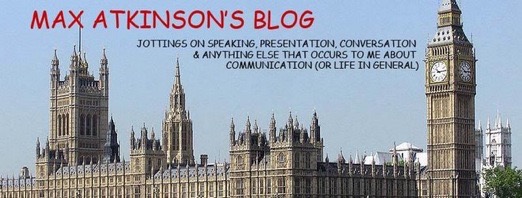
On a recent trip to Rome, I was reminded of the fact that it's commonly believed, at least by native speakers of English, that people who speak Latin-based languages seem to gesticulate more frequently and more vigorously than we do.
It wasn't that I saw lots of locals waiving their hands about, but I was struck by what a lot of writing there seemed to be on the road signs on the way into town from the airport.
Then, on entering the lift in the hotel, I was struck again by the length of the warning notice - so much so that I actually took a photograph of it (above).
The big difference between Italian and English isn't so much the number of words as the fact that the Italian version has twice as many syllables as the English translation:
IN CASO DI INCENDIO NON USARE L'ASCENSORE USARE LE SCALE (24 syllables)
IN CASE OF FIRE DO NOT USE THE LIFT USE THE STAIRS (12 syllables)
The point about syllables is that each one is a separate beat, so that the more beats there are in a sentence, the longer it will take to say it aloud.
This reminded me of some questions that originally occurred to me about thirty years ago as I was reading a notice about how to get into the lifeboats on a ferry between England and France - where two lines of English were translated into three lines of French.
- Are Latin languages inherently more 'long-winded' than English?
- If so, does this create problems for turn-taking that hadn't been noticed by research originally based on tape recordings of conversations between native speakers of English?
- If so, could a greater reliance on gestures be a practical solution to any such problems?
Combating the threat of an approaching bowl of potatoes
The reason why these questions occurred to me then was that I'd just returned from one of the first international conferences on conversation analysis at Boston University, where I'd taken part in a data session analysing a videotape of a dinner party at which a bowl of potatoes was being passed along the row of three diners on one side of the table.
A woman sitting opposite the man furthest away from the potatoes was telling him a story. When the potatoes reached the person next to him, she leant towards him and carried on with her tale. Then, a split second before the bowl reached the man being told the story, the speaker's hands suddenly came up from the table and she began to accompany her story with increasingly vigorous gestures.
The more the sequence was replayed, the more it looked as though her movements were precisely timed and choreographed with the movement of the bowl towards her listener. Leaning towards him came across as the first step in her bid to retain his undivided attention in the face of the growing threat of the approaching potatoes.
Her gestures, beginning as they did just before the bowl arrived in his hands, looked like an increasingly determined, if not desperate, effort to keep him listening.
So what?
If one of the things we do with gestures is to combat threats to the attentiveness of our listeners, this raises the question of whether speakers of Latin languages like Italian, Spanish and French have more reason to use them than speakers of a predominantly Germanic-Nordic language like English?
The number of beats/syllables needed to say the words in the Italian fire warning pictured above (or the lifeboat instructions on the cross-Channel ferry) points to a reason why the problem of holding attention may be greater in some languages than others - which would give speakers of those languages more of an incentive to use gestures.
Given that conversation depends on turn-taking, the longer a turn takes, the more of a challenge it is for listeners to remain attentive until the previous speaker has finished.
We know from some of the earliest work on turn-taking by the late Harvey Sacks that, if we're going to tell a story, we have to alert people to the fact in advance - so that they can prepare themselves for having to do more listening than usual.
So, if the production of sentences in language (A) requires more beats/syllables than the production of sentences in language (B), holding the attention of listeners will be inherently more of a problem for speakers of (A) than it is for speakers of (B).
And, if gestures help to hold attention, you would therefore expect speakers of language (A) to gesticulate more than speakers of language (B).
Culture, language or climate?
The standard way of explaining why Latin speakers are alleged to gesticulate more than English speakers is on the basis of ill-defined cultural generalisations along the lines that the Italians, French and Spanish are more 'emotional' and 'expressive' than people in Britain, North America and Australasia.
But there's an empirical vagueness to such claims that makes me rather more convinced by the idea that it has more to do with the way turn-taking is affected by inherent differences in the length of sentences in different languages (as measured by number of beats/syllables per sentence).
Or at least I was convinced until I mentioned the theory at another conference, where a Swedish delegate came up with a rather different, but nonetheless plausible, explanation:
"It's warm around the Mediterranean, but we native speakers of Swedish have to keep our hands in our pockets because it's too cold to waive them around all the time."





